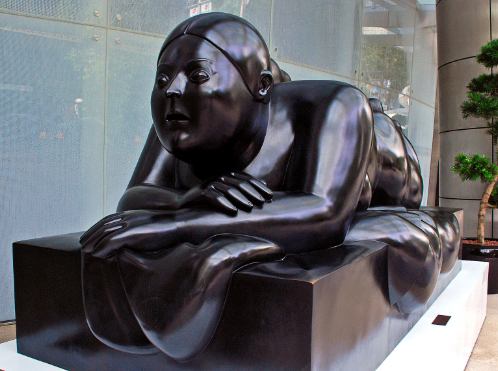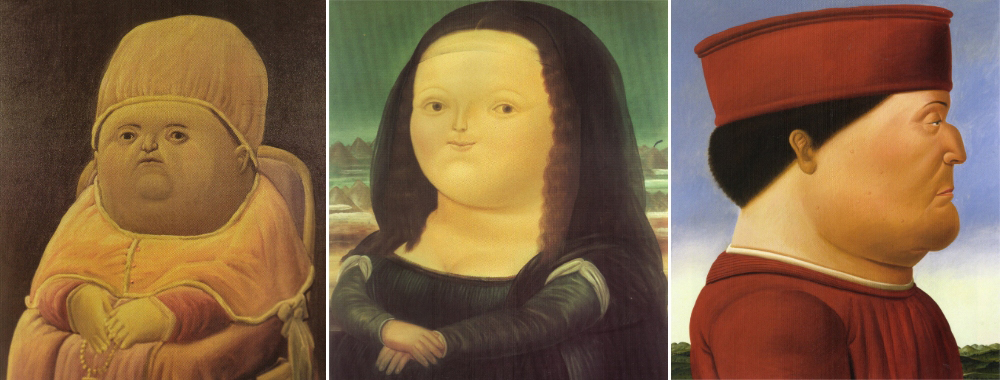 (Left) The sculpture ‘The Dancing Nude Couple’ is on public display at the foyer of the John Jacob Ballroom at The St. Regis Singapore. (Right) The master artist Fernando Botero. (Photo credit: Facebook/Botero Film)
(Left) The sculpture ‘The Dancing Nude Couple’ is on public display at the foyer of the John Jacob Ballroom at The St. Regis Singapore. (Right) The master artist Fernando Botero. (Photo credit: Facebook/Botero Film)
Fernando Botero,
Creator Of A
World Of
Well-Rounded
Figures
His son Fernando Botero Jr talks about his father's creative influence around the world at The St. Regis Singapore.
Maestro Fernando Botero, 87, is a renowned Colombian painter and sculptor, and one of the world’s most recognised living artists in modern times. His signature style, known as “Boterismo”, is his exaggerated voluminous stylisation of figures, animals and objects. The maestro’s art pieces can be found at several places in Singapore, including two housed at The St. Regis Singapore – ‘Reclining Woman’ (at the hotel entrance) and ‘The Dancing Nude Couple’ (at the foyer of the John Jacob Ballroom), while JW Marriott Singapore South Beach houses ‘Donna a Cavallo’ (at the hotel lobby). There is also a ‘fat bird’ statue (representing peace and optimism) strategically located at Boat Quay, the social waterfront of Singapore’s Central Business District and a major tourist spot.
Earlier this year, Fernando Botero Jr, 63, eldest son of the maestro, was in Singapore to share how happiness has guided his father’s hands as he creates his art pieces, the legacy and influence of his father’s work around the world, as well as the future of art.
When did Botero, your father, start working with St. Regis?
Botero has been working with The St. Regis Singapore since the opening of the hotel more than ten years ago. Guests visit The St. Regis Singapore not just because of the exceptional guest experience, but also because of the extensive art collection the hotel owns and displays.
There are two Botero structures at the hotel, the Dancing Couple located outside the main hotel ballroom where important meetings and weddings take place, and the Reclining Woman, that is displayed at the entrance of the hotel. These pieces have become not just icons at where they are located, but also within the city.
Asians, especially Singaporeans, have embraced Botero’s art pieces. What is it about the art pieces that people identify with?
I believe it is because the intention of Botero’s work has always been to generate happiness and pleasure. Botero believes that when people view his works, they would likewise feel or experience the same pleasure. The uniqueness of his style and the sensuality of his form tend to attract people. At the same time, his artworks typically feature ordinary local scenes when he was in Latin America – scenes of a picnic, a family or even a group of musicians. Most people can identify with local scenes, and local scenes always gain universal attraction.
 Fernando Botero Jr (standing), eldest son of the maestro, speaking to guests at Caroline's Mansion at The St. Regis Singapore about how Latin American life and the Renaissance masters have influenced his father’s art and inspiration. Caroline's Mansion is a new event space that opened at the hotel earlier this year.
Fernando Botero Jr (standing), eldest son of the maestro, speaking to guests at Caroline's Mansion at The St. Regis Singapore about how Latin American life and the Renaissance masters have influenced his father’s art and inspiration. Caroline's Mansion is a new event space that opened at the hotel earlier this year. The sculpture ‘Reclining Woman’, which is on public display at the entrance of The St. Regis Singapore. (Photo credit: Choo Yut Shing/Flickr)
The sculpture ‘Reclining Woman’, which is on public display at the entrance of The St. Regis Singapore. (Photo credit: Choo Yut Shing/Flickr)
Asia is rapidly becoming a centre for art. Why do you think so?
Asia has had a strong growing economy for the past 20 to 30 years. It has opened up to Western art in the past ten years thanks to the arrival of more art shows and auction houses. Before, Asia was more focused on local and historical art, but has certainly become more universal today – and it’s the same path most countries take; they start local, then go universal.
 The sculpture ‘Donna a Cavallo’ is on display at the lobby of JW Marriott Singapore South Beach.
The sculpture ‘Donna a Cavallo’ is on display at the lobby of JW Marriott Singapore South Beach.
 Another iconic statue is called ‘The Fat Pigeon’ or ‘The Bird’, which “landed” at UOB Plaza in Singapore, along Boat Quay in 1990. This statue has since gone viral worldwide and appeared in many tourists' photos due to its cute and stout appearance. (Photo credit: Andy Wright/Flickr)
Another iconic statue is called ‘The Fat Pigeon’ or ‘The Bird’, which “landed” at UOB Plaza in Singapore, along Boat Quay in 1990. This statue has since gone viral worldwide and appeared in many tourists' photos due to its cute and stout appearance. (Photo credit: Andy Wright/Flickr)
Has art acquisitions increased over the years? What does this say about the future of art?
Yes, of course. The art market has been growing at a steady pace, year on year. Return on investment of works by established artists is very clear and more stable, and we see a growth in that from established artists from the Renaissance and Impressionist periods, whose works are now many times more valuable than they were before.
Increasingly, people who seek art no longer just see art as décor for a new place, but rather, they see art as a piece of history, especially when it is from a recognised artist.
The future of art goes back to what has always been important. I believe we are now passing a period of time, where contemporary art goes through certain trends, and sometimes you need a PHD in art history to know what a work of art means.
But we need to go back to the essentials, to the people who understand the importance of paintings, drawings or sculpting. So artists who are really good at defining their style, with painting, with a sculpture, with drawings, will always be there in history. And now, people will start valuing more of the modern masters, the great painters of the Impressionist period, and the great painters of the Renaissance period.
 Botero also has an art series where puts his own take on some of the most well-known paintings in history. (Left) ‘Pope Leo X (after Raphael)’ was his spin on ‘The Portrait of Pope Leo X with Two Cardinals’ by Italian Renaissance master Raphael. The former is currently held in a private collection in Germany, and made it to popular culture after being popularised as an internet meme. (Centre) Botero’s take on the world-famous ‘Mona Lisa’ by Leonardo Da Vinci. The painting, which was done in 1978, is currently on display in Museo Botero in Bogota, Colombia. (Right) Botero’s ‘Federico da Montefeltro (after Piero della Francesca)’ was painted in 1998, and was inspired by the painting of Federigo da Montefeltro, a successful condottiere (Italian military leader) in the 15th century, done by Italian Renaissance painter Piero della Francesca in 1465. (Photo credits: Wikiart)
Botero also has an art series where puts his own take on some of the most well-known paintings in history. (Left) ‘Pope Leo X (after Raphael)’ was his spin on ‘The Portrait of Pope Leo X with Two Cardinals’ by Italian Renaissance master Raphael. The former is currently held in a private collection in Germany, and made it to popular culture after being popularised as an internet meme. (Centre) Botero’s take on the world-famous ‘Mona Lisa’ by Leonardo Da Vinci. The painting, which was done in 1978, is currently on display in Museo Botero in Bogota, Colombia. (Right) Botero’s ‘Federico da Montefeltro (after Piero della Francesca)’ was painted in 1998, and was inspired by the painting of Federigo da Montefeltro, a successful condottiere (Italian military leader) in the 15th century, done by Italian Renaissance painter Piero della Francesca in 1465. (Photo credits: Wikiart)






